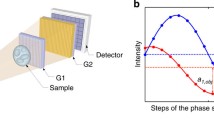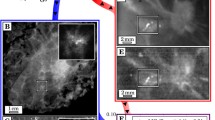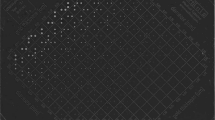Abstract
Objectives
Microcalcifications are an important feature in the diagnosis of breast cancer, especially in the early stages. In this paper, a CT-based method is proposed to potentially distinguish benign and malignant breast diseases based on the distributions of microcalcifications using grating-based phase-contrast imaging on a conventional X-ray tube.
Methods
The method presented based on the ratio of dark-field signals to attenuation signals in CT images is compared with the existing method based on the ratio in projections, and the threshold for the classification of microcalcifications in the two types of breast diseases is obtained using our approach. The experiment was operated on paraffin-fixed specimens that originated from 20 female patients ranging from 27–65 years old.
Results
Compared with the method based on projection images (AUC = 0.87), the proposed method is more effective (AUC = 0.95) to distinguish the two types of diseases. The discrimination threshold of microcalcifications for the classification of diseases in CT images is found to be 3.78 based on the Youden index.
Conclusions
The proposed method can be further developed to improve the early diagnosis and diagnostic accuracy and reduce the clinical misdiagnosis rate of breast cancer.
Key Points
• Microcalcifications are of special importance to indicate early breast cancer.
• Grating-based phase-contrast imaging can improve the diagnosis of breast cancers.
• The method described here can better classify benign and malignant breast diseases.





Similar content being viewed by others
References
WHO | Cancer, WHO 2016
Fasching PA, Ekici AB, Adamietz BR, et al (2011) Breast Cancer Risk - Genes, Environment and Clinics. Geburtshilfe Frauenheilkd 71:1056–1066
Hilleren DJ, Andersson IT, Lindholm K, Linnell FS (1991) Invasive lobular carcinoma: mammographic findings in a 10-year experience. Radiology 178:149–154
Brenner RJ, Pfaff JM (1996) Mammographic features after conservation therapy for malignant breast disease: Serial findings standardized by regression analysis. Am J Roentgenol 167:171–178
Sickles EA (2000) Breast Imaging: From 1965 to the Present1. Radiology 215:1–16
Anton G, Bayer F, Beckmann MW, et al (2013) Grating-based darkfield imaging of human breast tissue. Z Med Phys 23:228–235
Radi MJ (1989) Calcium oxalate crystals in breast biopsies. An overlooked form of microcalcification associated with benign breast disease. Arch Pathol Lab Med 113:1367–1369
Johnson JM (1999) Histological Correlation of Microcalcifications in Breast Biopsy Specimens. Arch Surg 134:712
Haka AS, Shafer-Peltier KE, Fitzmaurice M, Crowe J, Dasari RR, Feld MS (2002) Identifying microcalcifications in benign and malignant breast lesions by probing differences in their chemical composition using raman spectroscopy. Cancer Res. 62:5375–5380
Dahlstrom JE, Jain S (2001) Histological correlation of mammographically detected microcalcifications in stereotactic core biopsies. Pathology 33:444–448
Ellis IO, Humphreys S, Michell M, Pinder SE, Wells CA, Zakhour HD (2004) Best Practice No 179. Guidelines for breast needle core biopsy handling and reporting in breast screening assessment. J Clin Pathol 57:897–902
Cai W, Ning R (2009) Dose efficiency consideration for volume-of-interest breast imaging using x-ray differential phase-contrast CT. Proc SPIE 7258:72584D–72584D–9
Stampanoni M, Wang Z, Thüring T, et al (2011) The first analysis and clinical evaluation of native breast tissue using differential phase-contrast mammography. Invest Radiol 46:801–806
Hauser N, Wang Z, Kubik-Huch RA, et al (2014) A study on mastectomy samples to evaluate breast imaging quality and potential clinical relevance of differential phase contrast mammography. Invest Radiol 49:131–137
Sztrókay A, Herzen J, Auweter SD, et al (2013) Assessment of grating-based X-ray phase-contrast CT for differentiation of invasive ductal carcinoma and ductal carcinoma in situ in an experimental ex vivo set-up. Eur Radiol 23:381–387
Willner M, Herzen J, Grandl S, et al (2014) Quantitative breast tissue characterization using grating-based x-ray phase-contrast imaging. Phys Med Biol 59:1557–1571
Michette A, Buckley C (1993) X-ray science and technology
Keyrilainen J, Bravin A, Fernandez M, Tenhunen M, Virkkunen P, Suortti P (2010) Phase-contrast X-ray imaging of breast. Acta Radiol 51:866–884
Bonse U, Hart M (1965) An X-ray interferometer. Appl Phys Lett 6:155–156
Takeda M, Ina H, Kobayashi S (1982) Fourier-transform method of fringe-pattern analysis for computer-based topography and interferometry. J Opt Soc Am 72:156
Momose A, Fukuda J (1995) Phase-contrast radiographs of nonstained rat cerebellar specimen. Med Phys 22:375–379
Davis TJ, Gao D, Gureyev TE, Stevenson AW, Wilkins SW (1995) Phase-contrast imaging of weakly absorbing materials using hard X-rays. Nature 373:595–598
Chapman D, Thomlinson W, Johnston RE, et al (1997) Diffraction enhanced x-ray imaging. Phys Med Biol 42:2015–2025
Snigirev A, Snigireva I, Kohn V, Kuznetsov S, Schelokov I (1995) On the possibilities of x-ray phase contrast microimaging by coherent high-energy synchrotron radiation. Rev Sci Instrum 66:5486–5492
Wilkins SW, Gureyev TE, Gao D, Pogany A, Stevenson AW (1996) Phase-contrast imaging using polychromatic hard X-rays. Nature 384:335–338
Chen R, Liu P, Xiao T, Xu LX (2014) X-ray imaging for non-destructive microstructure analysis at SSRF. Adv Mater 26:7688–7691
David C, Nöhammer B, Solak HH, Ziegler E (2002) Differential x-ray phase contrast imaging using a shearing interferometer. Appl Phys Lett 81:3287–3289
Momose A (2003) Phase-sensitive imaging and phase tomography using X-ray interferometers. Opt Express 11:2303–2314
Pfeiffer F, Weitkamp T, Bunk O, David C (2006) Phase retrieval and differential phase-contrast imaging with low-brilliance X-ray sources. Nat Phys 2:258–261
David C, Weitkamp T, Pfeiffer F, et al (2007) Hard X-ray phase imaging and tomography using a grating interferometer. Spectrochim Acta B At Spectrosc 62:626–630
Pfeiffer F (2012) Milestones and basic principles of grating-based x-ray and neutron phase-contrast imaging. AIP Conf Proc 1466:2–11
Coan P, Bravin A, Tromba G (2013) Phase-contrast x-ray imaging of the breast: recent developments towards clinics. J Phys D Appl Phys 46:494007
Roessl E, Daerr H, Koehler T, Martens G, van Stevendaal U (2014) Clinical boundary conditions for grating-based differential phase-contrast mammography. Philos Trans R Soc A Math Phys Eng Sci 372:1–7
Fredenberg E, Danielsson M, Stayman JW, Siewerdsen JH, Aslund M, Åslund M (2012) Ideal-observer detectability in photon-counting differential phase-contrast imaging using a linear-systems approach. Med Phys 39:5317–5335
Olivo A, Gkoumas S, Endrizzi M, et al (2013) Low-dose phase contrast mammography with conventional x-ray sources. Med Phys 40:90701
Morita T, Yamada M, Kano A, Nagatsuka S, Honda C, Endo T (2008) A comparison between film-screen mammography and full-field digital mammography utilizing phase contrast technology in breast cancer screening programs. Digital Mammography 2008:48–54
Tanaka T, Honda C, Matsuo S, et al (2005) The first trial of phase contrast imaging for digital full-field mammography using a practical molybdenum x-ray tube. Invest Radiol 40:385–396
Michel T, Rieger J, Anton G, et al (2013) On a dark-field signal generated by micrometer-sized calcifications in phase-contrast mammography. Phys Med Biol 58:2713–2732
Wang Z, Hauser N, Singer G, et al (2014) Non-invasive classification of microcalcifications with phase-contrast X-ray mammography. Nat Commun 5:3797
Scherer KH (2016) Grating-Based X-Ray Phase-Contrast Mammography. Technical University of Munich, Germany
Wang ZT, Kang KJ, Huang ZF, Chen ZQ (2009) Quantitative grating-based x-ray dark-field computed tomography. Appl Phys Lett 95:94105
Maier A, Hofmann HG, Berger M, et al (2013) CONRAD--a software framework for cone-beam imaging in radiology. Med Phys 40:111914
Fawcett T (2006) An introduction to ROC analysis. Pattern Recognit Lett 27:861–874
Hanley JA, McNeil BJ (1982) The meaning and use of the area under a receiver operating characteristic (ROC) curve. Radiol Illinois 143:29–36
Zweig MH, Campbell G (1993) Receiver-operating characteristic (ROC) plots: A fundamental evaluation tool in clinical medicine. Clin. Chem. 39:561–577
Youden WJ (1950) Index for rating diagnostic tests. Cancer 3:32–35
Schisterman EF, Perkins NJ, Liu A, Bondell H (2005) Optimal cut-point and its corresponding Youden Index to discriminate individuals using pooled blood samples. Epidemiology 16:73–81
Ruopp MD, Perkins NJ, Whitcomb BW, Schisterman EF (2008) Youden Index and optimal cut-point estimated from observations affected by a lower limit of detection. Biometrical J. 50:419–430
Scherer K, Willer K, Gromann L, et al (2015) Toward Clinically Compatible Phase-Contrast Mammography. PLoS One 10:e0130776
Grandl S, Scherer K, Sztrokay-Gaul A, et al (2015) Improved visualization of breast cancer features in multifocal carcinoma using phase-contrast and dark-field mammography: an ex vivo study. Eur Radiol 25:3659–3668
Scherer K, Birnbacher L, Chabior M, et al (2014) Bi-directional x-ray phase-contrast mammography. PLoS One 9:e93502
Liu J, Cai W, Ning R (2016) Evaluation of differential phase contrast cone beam CT imaging system. J Xray Sci Technol 25:357–372
Ge Y, Li K, Garrett J, Chen GH (2014) Grating based x-ray differential phase contrast imaging without mechanical phase stepping. Opt Express 22:14246–14252
Kagias M, Wang Z, Villanueva-Perez P, Jefimovs K, Stampanoni M (2016) 2D-Omnidirectional Hard-X-Ray Scattering Sensitivity in a Single Shot. Phys Rev Lett 116:93902
Momose A, Yashiro W, Harasse S, Kuwabara H (2011) Four-dimensional X-ray phase tomography with Talbot interferometry and white synchrotron radiation: dynamic observation of a living worm. Opt Express 19:8423–8432
Wang Z, Huang Z, Zhang L, et al (2011) Low dose reconstruction algorithm for differential phase contrast imaging. J Xray Sci Technol 19:403–415
Stutman D, Finkenthal M (2012) Glancing angle Talbot-Lau grating interferometers for phase contrast imaging at high x-ray energy. Appl. Phys. Lett. 101:1–6
Zanette I, Bech M, Rack A, et al (2012) Trimodal low-dose X-ray tomography. Proc Natl Acad Sci U S A 109:10199–10204
Miao H, Chen L, Bennett EE, et al (2013) Motionless phase stepping in X-ray phase contrast imaging with a compact source. Proc Natl Acad Sci 110:19268–19272
Bevins N, Zambelli J, Li K, Qi Z, Chen G-H (2012) Multicontrast x-ray computed tomography imaging using Talbot-Lau interferometry without phase stepping. Med Phys 39:424
Marschner M, Willner M, Potdevin G, et al (2016) Helical X-ray phase-contrast computed tomography without phase stepping. Sci Rep 6:23953
Xie H, Cai W, Yang L, Mao H, Tang X (2016) Reducing radiation dose in grating based x-ray phase contrast CT with twin-peaks in its phase stepping curves. Med Phys 43:5942–5950
Funding
This study has received funding by the National Natural Science Foundation of China (No. 11235007) and a Tsinghua University Independent Research Project Grant, “Research on Key Technologies and CT Reconstruction methods of multi-energy X-ray imaging”.
Author information
Authors and Affiliations
Corresponding author
Ethics declarations
Guarantor
The scientific guarantor of this publication is Zhiqiang Chen.
Conflict of interest
The authors of this manuscript declare no relationships with any companies whose products or services may be related to the subject matter of the article.
Statistics and biometry
One of the authors, Shengping Wang, has significant statistical expertise.
Ethical approval
Institutional Review Board approval was obtained.
Informed consent
Written informed consent was obtained from all subjects (patients) in this study.
Methodology
• prospective
• experimental
• performed at one institution
Rights and permissions
About this article
Cite this article
Li, X., Gao, H., Chen, Z. et al. Diagnosis of breast cancer based on microcalcifications using grating-based phase contrast CT. Eur Radiol 28, 3742–3750 (2018). https://doi.org/10.1007/s00330-017-5158-4
Received:
Revised:
Accepted:
Published:
Issue Date:
DOI: https://doi.org/10.1007/s00330-017-5158-4




